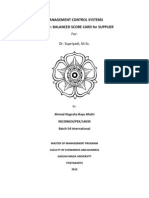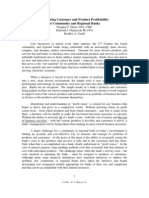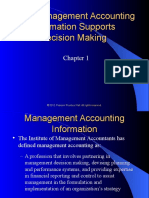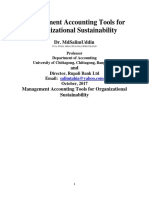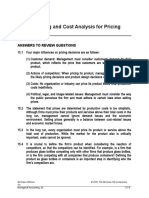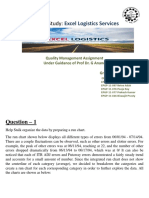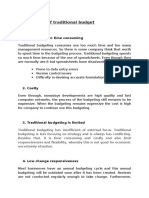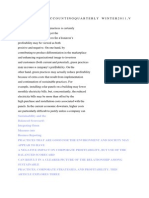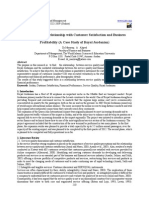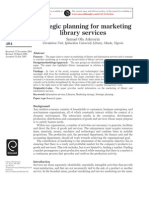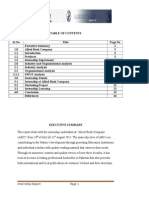100%(1)100% found this document useful (1 vote)
622 viewsSustainability Balanced Scorecard
Sustainability Balanced Scorecard
Uploaded by
Budi PrasetioThe document discusses using a Sustainability Balanced Scorecard (SBSC) to integrate sustainability goals into corporate strategy. An SBSC links environmental, social and economic management systems by incorporating sustainability aspects into a company's standard balanced scorecard. This helps evaluate sustainability initiatives' contribution to financial success. An SBSC can integrate sustainability in existing scorecard perspectives, add a new "non-market" perspective, or create standalone sustainability scorecards. The SBSC process must strategically prioritize issues to fully integrate sustainability management into overall business management.
Copyright:
Attribution Non-Commercial (BY-NC)
Available Formats
Download as PPT, PDF, TXT or read online from Scribd
Sustainability Balanced Scorecard
Sustainability Balanced Scorecard
Uploaded by
Budi Prasetio100%(1)100% found this document useful (1 vote)
622 views16 pagesThe document discusses using a Sustainability Balanced Scorecard (SBSC) to integrate sustainability goals into corporate strategy. An SBSC links environmental, social and economic management systems by incorporating sustainability aspects into a company's standard balanced scorecard. This helps evaluate sustainability initiatives' contribution to financial success. An SBSC can integrate sustainability in existing scorecard perspectives, add a new "non-market" perspective, or create standalone sustainability scorecards. The SBSC process must strategically prioritize issues to fully integrate sustainability management into overall business management.
Copyright
© Attribution Non-Commercial (BY-NC)
Available Formats
PPT, PDF, TXT or read online from Scribd
Share this document
Did you find this document useful?
Is this content inappropriate?
The document discusses using a Sustainability Balanced Scorecard (SBSC) to integrate sustainability goals into corporate strategy. An SBSC links environmental, social and economic management systems by incorporating sustainability aspects into a company's standard balanced scorecard. This helps evaluate sustainability initiatives' contribution to financial success. An SBSC can integrate sustainability in existing scorecard perspectives, add a new "non-market" perspective, or create standalone sustainability scorecards. The SBSC process must strategically prioritize issues to fully integrate sustainability management into overall business management.
Copyright:
Attribution Non-Commercial (BY-NC)
Available Formats
Download as PPT, PDF, TXT or read online from Scribd
Download as ppt, pdf, or txt
100%(1)100% found this document useful (1 vote)
622 views16 pagesSustainability Balanced Scorecard
Sustainability Balanced Scorecard
Uploaded by
Budi PrasetioThe document discusses using a Sustainability Balanced Scorecard (SBSC) to integrate sustainability goals into corporate strategy. An SBSC links environmental, social and economic management systems by incorporating sustainability aspects into a company's standard balanced scorecard. This helps evaluate sustainability initiatives' contribution to financial success. An SBSC can integrate sustainability in existing scorecard perspectives, add a new "non-market" perspective, or create standalone sustainability scorecards. The SBSC process must strategically prioritize issues to fully integrate sustainability management into overall business management.
Copyright:
Attribution Non-Commercial (BY-NC)
Available Formats
Download as PPT, PDF, TXT or read online from Scribd
Download as ppt, pdf, or txt
You are on page 1of 16
Sustainability Balanced Scorecard
Professor Doug Cerf
Donald Bren Graduate School of Environmental
Science and Management
Environmental Accounting &Financial
Management (ESM 284)
Spring 2007
Internal Management tool to
operationalize sustainability goals
from the company’s strategic plan
Sustainability Balanced Scorecard
• Introduction to Balanced Scorecard
– See Introduction to Balanced Scorecard.ppt
• Presentation based on
– The Sustainability Balanced Scorecard –
Linking Sustainability Management to Business
Strategy” Figge, Hahn, Schaltegger and
Wagner, Center for Sustainability Management
University of Lüneburg, Germany
Printed on recycled paper-actually
better, not printed at all
Overview
• Overall goal is to implement sustainability issues
in the company’s strategic plan through the
balanced scorecard system
• Balanced Scorecard is a promising starting-point
to incorporate environmental and social aspects
into the main management system of a firm.
• Sustainability management with Balanced
Scorecard helps to overcome the shortcomings of
conventional approaches to environmental and
social management systems by integrating the
three pillars of sustainability into a single and
overarching strategic management tool.
Printed on recycled paper-actually
better, not printed at all
Link environmental and social management
systems to economic management systems
• Many companies have implemented specific
environmental or social management systems during the
last decade.
• These systems have, however, rarely been integrated with
the general management system of a firm.
• As a consequence environmental and social management is
often not linked to the economic success of the firm
• Consequently, the economic contribution of environment
and social management therefore remains unclear.
• This lack of integration is a major obstacle.
Printed on recycled paper-actually
better, not printed at all
The correlation between environmental,
social success and economic success
• the literature is mainly based on empirical studies
that refer to the correlation but not to the causality
between environmental and social measures and
the economic success of firms
• To date there is a small amount of literature on the
relation between environmental and social
measures and the achievement of long-term
economic goals
Printed on recycled paper-actually
better, not printed at all
Suitability of balanced scorecard as a tool for
sustainability management
• Management should first identify and realize
opportunities for simultaneous improvements in
all three dimensions of sustainability (social,
ecological and economic goals) in order to achieve
strong corporate contributions to sustainability
• SBSC offers the possibility to integrate the
management of environmental and social aspects
into mainstream business activities
Printed on recycled paper-actually
better, not printed at all
Integrating Sustainability into BSC
• Integrating the three pillars of sustainability into general
business management (ie:BSC) offers three major
advantages
– Sustainability management that is economically sound
will be practiced in successful and unsuccessful
economic periods
– Sustainability management that also contributes to
economic objectives helps to disseminate the idea of
sustainable development in business, as it serves as an
appropriate role model for other businesses.
– a business improves performance with regard to all the
three dimensions of sustainability simultaneously
Printed on recycled paper-actually
better, not printed at all
Methods of integration
• Three possibilities to integrate environmental and
social aspects in the BSC
– Environmental and social aspects integrated in the
existing four standard perspectives.
– An additional perspective added to take environmental
and social aspects into account
– A specific environmental and/or social scorecard is
formulated
• Preferred in the listed order
• A combination of these approaches is appropriate
Printed on recycled paper-actually
better, not printed at all
Integration into the four balanced scorecard
perspectives
• Similar to adding any other strategic aspect that is
relevant to a particular perspective
• Through a top down approach
– Environmental and social aspects are integrated
through respective strategic core elements or
performance drivers
– lagging and leading indicators as well as targets and
measures are formulated
• particularly appropriate for environmental and
social aspects that are already integrated in the
market system. Printed on recycled paper-actually
better, not printed at all
Example
• a firm that aims at an environmental
customer segment
– the core measure ‘market share’ in the customer
perspective would have an environmentally
oriented dimension
– the leading indicator ‘product features’ would
have an environmental dimension
• Environmentally friendly packaging
Printed on recycled paper-actually
better, not printed at all
Addition of non market perspective
• Environmental and social aspects are not fully integrated
in the market exchange processes
– Example: externalities—non market portion of C02 pollution
• Consequently a non market perspective needs to be added
to incorporate these strategic aspects
• In order to justify introduction of an additional non-market
perspective, environmental and social aspects from outside
the market system must explicitly represent strategic core
aspects of the firm
• Should only be used if the aspects can not be represented
within the standard four perspectives
Printed on recycled paper-actually
better, not printed at all
A specific environmental and/or
social scorecard is formulated
• Predominantly used to coordinate, organize and
further differentiate the environmental and social
aspects
• Should not be developed parallel to the
conventional scorecard
• In order to integrate sustainability management
into mainstream business management
– Must be added in conjunction with one of the other two
integration alternatives
– This is not an independent alternative for integration, it
is an extensionPrinted on recycled paper-actually
better, not printed at all
The process of formulating an SBSC has to
meet the following……
• must lead to integration of
environmental and social management
into business management
• the SBSC is business unit specific
• environmental and social aspects of a
business unit must be integrated
according to their strategic relevance
Printed on recycled paper-actually
better, not printed at all
The process of formulating an
SBSC
Printed on recycled paper-actually
better, not printed at all
Printed on recycled paper-actually
better, not printed at all
You might also like
- C2 Crafting & Executing Strategy 21eDocument60 pagesC2 Crafting & Executing Strategy 21eMuthia Khairani50% (2)
- Nutratask Inc Is A Pharmaceutical Manufacturer of Amino Acid Chelated Minerals andDocument3 pagesNutratask Inc Is A Pharmaceutical Manufacturer of Amino Acid Chelated Minerals andAmit PandeyNo ratings yet
- Michael Levy Barton Weitz Ajay PanditDocument47 pagesMichael Levy Barton Weitz Ajay PanditfeisalNo ratings yet
- Chapter 1Document37 pagesChapter 1shams221No ratings yet
- Balanced Score CardDocument14 pagesBalanced Score CardBayu Mukti100% (3)
- Summary of WalmartDocument2 pagesSummary of WalmartkhusbuNo ratings yet
- Mechanics of Financial Accounting RevisedDocument4 pagesMechanics of Financial Accounting RevisedalakshendraNo ratings yet
- Assignment - Group 2 - Prestige Telephone CompanyDocument4 pagesAssignment - Group 2 - Prestige Telephone Companyjohnychauhan1No ratings yet
- Amanco: Sustainable Balanced Scorecard Harvard Case: Evolution of An Internal Strategic Management ToolDocument11 pagesAmanco: Sustainable Balanced Scorecard Harvard Case: Evolution of An Internal Strategic Management ToolMahendra PrabhuNo ratings yet
- Responsibility CenterDocument14 pagesResponsibility CenterKashif TradingNo ratings yet
- Taran SwanDocument3 pagesTaran Swancmugrad1No ratings yet
- Final Exam 5006 Essay - Farid Ardika Dasum - 29120020Document6 pagesFinal Exam 5006 Essay - Farid Ardika Dasum - 29120020rizqighaniNo ratings yet
- Finanacial Statements: Balance Sheet & Profit and Loss AccountDocument26 pagesFinanacial Statements: Balance Sheet & Profit and Loss AccountAshok SeerviNo ratings yet
- Case 2 S 1 Apple The Iphone Turns 10 PDFDocument20 pagesCase 2 S 1 Apple The Iphone Turns 10 PDFMifta ZanariaNo ratings yet
- Solution For Case Chapter 1 Business Economics - SG2 - SLEMBA1 - 2021Document13 pagesSolution For Case Chapter 1 Business Economics - SG2 - SLEMBA1 - 2021Fadhila Nurfida HanifNo ratings yet
- Ch. 11. Performance MeasurementDocument12 pagesCh. 11. Performance MeasurementHILDANo ratings yet
- Chap 5 - MRPDocument75 pagesChap 5 - MRPladdooparmarNo ratings yet
- Customer and Product Profitability at BanksDocument15 pagesCustomer and Product Profitability at Banksmuhaayan87100% (1)
- How Management Accounting Information Supports Decision MakingDocument36 pagesHow Management Accounting Information Supports Decision MakingZbRZivPQ51pEZ9PUNo ratings yet
- Dalci / CPA With TDABCDocument30 pagesDalci / CPA With TDABCAnastasiaNo ratings yet
- Management Accounting Tools For Organisational SustainabilityDocument53 pagesManagement Accounting Tools For Organisational SustainabilityBishal bishal100% (2)
- Four Levels of Control EnglishDocument6 pagesFour Levels of Control EnglishgladysNo ratings yet
- Budgetary Control and Standard CostingDocument15 pagesBudgetary Control and Standard CostingPratyay DasNo ratings yet
- Chapter 14 Communicating Customer ValueDocument7 pagesChapter 14 Communicating Customer ValueTaylor Kalinowski100% (4)
- Employee Based Productivity Improvement Technique-By Sudipto and RameshDocument19 pagesEmployee Based Productivity Improvement Technique-By Sudipto and Rameshmohit vatsNo ratings yet
- When The Tone of An Email Went Wrong Case Study AnalysisDocument4 pagesWhen The Tone of An Email Went Wrong Case Study AnalysisHimanshu SinghNo ratings yet
- Master Budget: Presentation Prepared byDocument10 pagesMaster Budget: Presentation Prepared byMohit AgarwalNo ratings yet
- Solutions/solution Manual15Document50 pagesSolutions/solution Manual15Bea BlancoNo ratings yet
- Group-03: SIEMENS: Building A Structure To Drive Performance and ResponsibilityDocument6 pagesGroup-03: SIEMENS: Building A Structure To Drive Performance and ResponsibilityRohit KaliaNo ratings yet
- The e Ffect of Enterprise Risk Management On Financial Performance and Firm Value: The Role of Environmental, Social and Governance PerformanceDocument24 pagesThe e Ffect of Enterprise Risk Management On Financial Performance and Firm Value: The Role of Environmental, Social and Governance PerformanceNitin Basoya100% (1)
- © 2012 Pearson Prentice Hall. All Rights ReservedDocument28 pages© 2012 Pearson Prentice Hall. All Rights ReservedRaktimNo ratings yet
- Profit MaximazationDocument36 pagesProfit MaximazationFrank Babu100% (1)
- Case Study Boeing by RidwanDocument4 pagesCase Study Boeing by Ridwanridwan satryoNo ratings yet
- Chap 008Document26 pagesChap 008Citra Dewi WulansariNo ratings yet
- Uts Tom 2021Document4 pagesUts Tom 2021Randhy WicaksonoNo ratings yet
- Report Maf 635Document13 pagesReport Maf 635Nabila NazirahNo ratings yet
- The Integrated Report FrameworkDocument5 pagesThe Integrated Report FrameworkteslimsNo ratings yet
- Moving From Traditional Marketing To Digital MarketingDocument8 pagesMoving From Traditional Marketing To Digital MarketingPravin100% (1)
- MBA Class of 2013 Sem 3 Course Handouts PDFDocument155 pagesMBA Class of 2013 Sem 3 Course Handouts PDFSradha Saha25% (4)
- Ratio AnalysisDocument33 pagesRatio AnalysisJhagantini PalaniveluNo ratings yet
- Dwitya Aribawa - Management Control System Chapter 3 - RENDELL COMPANYDocument3 pagesDwitya Aribawa - Management Control System Chapter 3 - RENDELL COMPANYDwitya AribawaNo ratings yet
- (2018) MM5006 Business EconomicsDocument20 pages(2018) MM5006 Business EconomicsRivai Vai SNo ratings yet
- Capital BudgetingDocument12 pagesCapital BudgetingPankaj TiwariNo ratings yet
- Analytical & Thinking: CreativeDocument34 pagesAnalytical & Thinking: CreativebendiNo ratings yet
- 7 The Value of ParentxDocument20 pages7 The Value of ParentxArifaniRakhmaPutriNo ratings yet
- Sustainability 12 06136Document13 pagesSustainability 12 06136Sagitarius SagitariaNo ratings yet
- Parenting AdvantageDocument14 pagesParenting AdvantageZ Babar Khan100% (2)
- Siemens Team5Document8 pagesSiemens Team5nevin04No ratings yet
- Jurnal Marketing 4.0Document9 pagesJurnal Marketing 4.0Benedictus Rosario ArdeliantoNo ratings yet
- Case Study On Solartronics, IncDocument3 pagesCase Study On Solartronics, IncSrishti Wadhwa100% (2)
- Management Accounting Best Practices Award For Improving Corruption in Public Sector AgenciesDocument7 pagesManagement Accounting Best Practices Award For Improving Corruption in Public Sector AgenciesESTERNo ratings yet
- CHP 13 14 PDFDocument39 pagesCHP 13 14 PDFLara HarbNo ratings yet
- QM Excel LogisticDocument20 pagesQM Excel LogisticBiswajit PrustyNo ratings yet
- 1 What Is Control System?Document9 pages1 What Is Control System?Sohel MahamudNo ratings yet
- 06 Push Pull StrategiesDocument14 pages06 Push Pull Strategieslencerti100% (1)
- Chp17 Leadership, Org CSR-20190930074449Document24 pagesChp17 Leadership, Org CSR-20190930074449Vinnodth ShankarNo ratings yet
- Weaknesses of Traditional BudgetDocument2 pagesWeaknesses of Traditional BudgetBoey Bao YiNo ratings yet
- Solomon cb09 PPT 06Document40 pagesSolomon cb09 PPT 06Youssef BahaidarNo ratings yet
- A Framework For Sustainable MarketingDocument22 pagesA Framework For Sustainable MarketingHalyna NguyenNo ratings yet
- Wheelen 14e ch06Document37 pagesWheelen 14e ch06syakirahNo ratings yet
- Integrating Green Measures Into Business ReportingDocument23 pagesIntegrating Green Measures Into Business ReportingToton HartantoNo ratings yet
- Carded RewriteDocument8 pagesCarded RewriteRyan Teichmann50% (2)
- CleanSpritz Group8Document7 pagesCleanSpritz Group8shivam sharmaNo ratings yet
- Service Quality Relationship With Customer Satisfaction and Business Profitability (A Case Study of Royal Jordanian)Document7 pagesService Quality Relationship With Customer Satisfaction and Business Profitability (A Case Study of Royal Jordanian)Yee Yee 怡No ratings yet
- IGCSE Business Studies 0450 Sample Question PaperDocument16 pagesIGCSE Business Studies 0450 Sample Question Paperaditi.mishraNo ratings yet
- Conjoint AnalysisDocument14 pagesConjoint AnalysisaniljoepaulNo ratings yet
- Strategic Planning For Marketing Library Services: Circulation Unit, Igbinedion University Library, Okada, NigeriaDocument14 pagesStrategic Planning For Marketing Library Services: Circulation Unit, Igbinedion University Library, Okada, Nigeriajohnisco20044729No ratings yet
- MacNeil Automotive Products v. Kramer America Et. Al.Document38 pagesMacNeil Automotive Products v. Kramer America Et. Al.PriorSmartNo ratings yet
- Chapter 14Document38 pagesChapter 14AdilNo ratings yet
- SWOT AnalysisDocument13 pagesSWOT AnalysisDeepika SarodeNo ratings yet
- McKinsey 7S FrameworkDocument2 pagesMcKinsey 7S FrameworkSai NeerajNo ratings yet
- Short Notes of International MarketingDocument17 pagesShort Notes of International MarketingJames ManningNo ratings yet
- Trademarks and Twitter: The Costs and Benefits of Social Media On Trademark Strength, and What This Means For Internet-Savvy CelebsDocument25 pagesTrademarks and Twitter: The Costs and Benefits of Social Media On Trademark Strength, and What This Means For Internet-Savvy CelebsNew England Law ReviewNo ratings yet
- Positioning PDFDocument13 pagesPositioning PDFKris NugrozNo ratings yet
- Funnel U38Document24 pagesFunnel U38nguyentanhai100% (1)
- Business Financials MRFDocument13 pagesBusiness Financials MRFarshdhirNo ratings yet
- Competitive Intelligence ReportDocument4 pagesCompetitive Intelligence ReportPham TuyenNo ratings yet
- Internship ReportDocument15 pagesInternship ReportSHOAIB0% (1)
- Need Canvas: All Stakeholders Key Stakeholders Needs Pain Points Pics Pain PointsDocument1 pageNeed Canvas: All Stakeholders Key Stakeholders Needs Pain Points Pics Pain PointsYash DesaiNo ratings yet
- Data For DubaiDocument3 pagesData For DubaipoojaNo ratings yet
- Titan RagaDocument4 pagesTitan RagaratneshssitNo ratings yet
- It All Started With A VisionDocument22 pagesIt All Started With A VisionJersli TongolNo ratings yet
- How Much Do Boycotts Affect A Company's Bottom LineDocument6 pagesHow Much Do Boycotts Affect A Company's Bottom LinenguyenduongthungocNo ratings yet
- Introduction To Aviation IndustryDocument10 pagesIntroduction To Aviation IndustryMohd MohsinNo ratings yet
- RMB 2011-13 Batch LecturesDocument33 pagesRMB 2011-13 Batch Lecturesstraightedge23No ratings yet
- MSQ-01 - Cost Behavior & CVP AnalysisDocument10 pagesMSQ-01 - Cost Behavior & CVP AnalysisDanica Reyes QuintoNo ratings yet
- Nova Tech GuideDocument36 pagesNova Tech Guidesk0rstfxNo ratings yet
- Data Mining For Customer SegmentationDocument13 pagesData Mining For Customer SegmentationRahul RanganathanNo ratings yet




